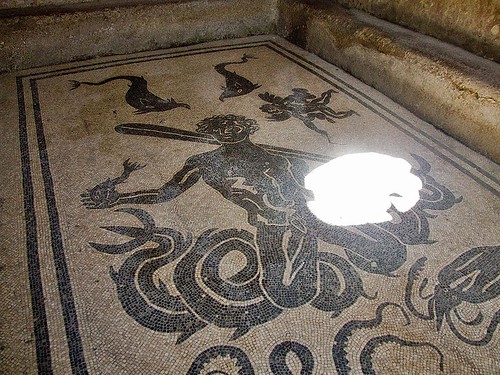Herculaneum is Pompeii's lesser but better preserved sister-city. Sort of like the Joseph Fiennes. Or, Harrogate, in fact. For those of you who don't know it, Harrogate is like a small island of Surry in the otherwise grimdark North Yorkshire. Here's a nice picture of it.
Herculaneum was just down the road from Pompeii, but was destroyed by pyroclastic flows, rather than ash and lava. This means that much of the organic material was carbonised, rather than simply burned, so it survives. Therefore, we have doors, screens and sometimes food preserved! (There will probably be a forthcoming blog about some of the awesome evidence from Herculaneum). Herculaneum was smaller than Pompeii, and its population was wealthier: like Harrogate and its neighbour, Leeds!
Here are two comparisons in greater detail:
Houses
Both Harrogate and Herculaneum were, for most people, lovely places to live. The houses in Herculaneum were often laid out to a recognisable plan: large, grand doors and entrance halls faced onto the street, like this one:
Behind would be a large atrium, decorated in one of four styles. The style depended on the family: were they wealthy enough to keep up to date, and did they want to emphasise their antiquity with a conspicous "old fashioned" style? A bit like deciding if you want to Tudor the front of your house, really. Alongside the atrium would be functional rooms like bedrooms, and behind it, a large and imposing study. Through the study was usually a large and delightful garden. They had slaves to look after them, so the hot weather or indifference of the owners was no excuse. Cicero said "If you have a library and a garden, you have everything you need". And Cicero never did a day's work in his life (Unfair; he actually worked really hard, but I just had to read all of On The Laws and now I hate him. For at least another week.)
The gardens were usually decorated with wall paintings and statues, like these.
Admittedly, this guy (The Faun) is actually from Pompeii.
Harrogate shows similar trends: many houses are large and imposing, with grand gardens. Here are some comparason pictures.
Look Familiar?
Baths
Baths! The Romans were famous for their baths. We named a whole town after one: Bath!
Harrogate is also a famous spa town, still boasting its own Turkish Baths and Spa. In Harrogate, you pay a large amount of money to be treated to the finest in beauty treatments, or something. I've never actually been there. In Herculaneum, the public baths were just that: public. And even better, they were free, though you probably had to tip the slave in the changing rooms to stop people stealing your stuff, and pay someone else to have a slave scrape all your dead skin off. The ancient sources suggest this was a more pleasent experience than that implies. Here are some lovely pictures of Herculaneum's baths.
Bathing followed a structure; you didn't just get into the pool and splash about. There were three main rooms: the caldarium, the tepidarium and the frigidarium. As these names might suggest, they were hot, medium and cold. The idea was to enjoy a pleasent sweat in the caldarium, struggle back through to the pleasent tepidarium, and then plunge into the cold water of the frigidarium, usually painted blue to emphasise the feeling of cold.
The lines on the ceiling are grooves to make channels for the condensation
This is from a villa in France, but it clearly shows the stacks and the inlet for the smoke
So there you have it: next time you feel like jetting off somewhere ancient and exotic, think not of the bay of Naples, but of sunny Harrogate. Like all the best places, it's Grim Up North.









No comments:
Post a Comment